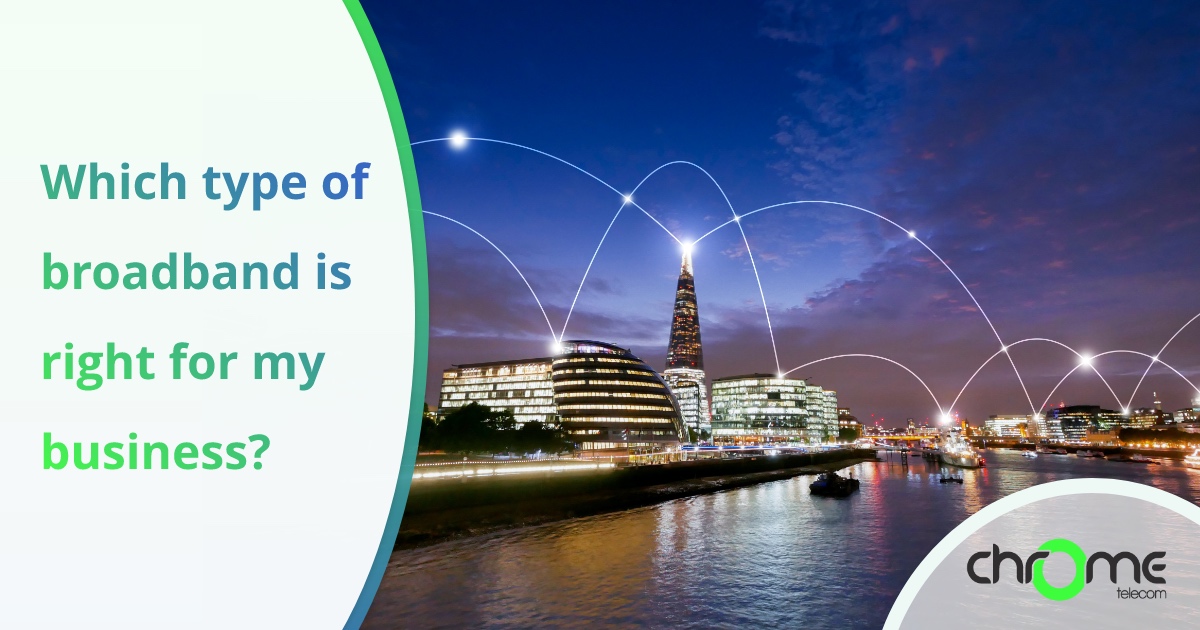Looking for a new broadband connection can be tricky if you’re not very techy. The connectivity marketplace is littered with technical jargon and arcane measurements. It can be difficult to relate terms back to your work – of course higher speed is better, but how much do you actually need?
This guide will give a quick overview of the major types of broadband in use across the UK, helping you get to grips with what’s available. If you don’t know FTTP from FTTC, or you’re not sure whether you should choose Fibre or ADSL, this guide is for you.
FTTC – The business workhorse
FTTC is replacing ADSL as the backbone of the UK’s business connectivity. Standing for Fibre To The Cabinet, FTTC replaces aging copper cabling with the latest high-speed fibre optics. Although the fibre only runs as far as the cabinet at the end of your street, FTTC is a massive upgrade over its older ADSL cousin. FTTC is a good match for the majority of smaller and medium sized offices.
Speed: Up to 80Mbps. To give a little context, that’s enough for more than a dozen simultaneous HD Netflix streams.
Availability: Practically universal in towns. Available at more than 95% of UK addresses.
Pros:
– Cost-effective.
– Very fast to set up.
– More responsive and faster than older copper-only connections.
Cons:
– Not as fast as g.fast or FTTP.
– Not yet available in some more rural locations.
Suitable for: Small and medium sized offices with up to 30 users.
FTTP – The latest and greatest
FTTP stands for Fibre To The Premises. As the name suggests, FTTP upgrades FTTC connections by bringing the faster fibre lines all the way to your door. The fastest standard connection around, FTTP is ideal for large offices making heavy use of cloud services.
Speed: Up to 300Mbps. That’s enough for 12 simultaneous 4K UHD Netflix streams, or over a hundred HD video calls.
Availability: Currently low, although expanding rapidly.
Pros:
– Incredibly fast.
– Even more responsive than FTTC.
Cons:
– Availability is quite limited.
– Installation can be costly.
Suitable for: Larger offices with 30+ users.
G.Fast – The new kid on the block
G.Fast is a new technology that supercharges your FTTC connection to provide speeds that can match even an FTTP connection. G.Fast is a hybrid connection, giving you the speed of FTTP over a short copper line into your premises.
Speed: Up to 300Mbps, depending on the distance to your local exchange.
Availability: Available at nearly 3 million premises across the UK.
Pros:
– G.Fast is the fastest connection around if FTTP is not yet available for you.
– Cost-effective monthly rental.
Cons:
– The speed you will receive depends on the distance to your exchange.
– Installation requires an engineer visit.
Suitable for: Larger offices with 30+ users.
ADSL – Ol’ Faithful
If you’re lucky enough to work in a beautiful rural location, you might not have access to a Fibre connection. Not to worry! ADSL connections are available at all UK addresses, providing a cost-effective and reliable connection to your cloud services and your customers.
Speed: Up to 24Mbps, good enough for 5 simultaneous HD Netflix streams.
Availability: Everywhere.
Pros:
– Reliable, well-proven technology.
– Available at all addresses.
– Very fast and simple to install.
Cons:
– Response times are quite slow compared to Fibre connections.
– Limited bandwidth
Suitable for: Rural businesses or small offices of up to 10 users.
Leased Lines – Keep everything to yourself
Leased Lines are your own private slice of the internet. The most highly configurable connection around, Leased Lines give you complete control over your broadband. Industry-leading SLAs keep you connected, and symmetric upload and download speeds ensure smooth access to your in-house servers.
Speed: It’s up to you! Leased Lines are available from 10Mbps up to 1Gbps.
Availability: Everywhere.
Pros:
– Leased Lines guarantee more than 99.9% uptime, making them ideal for businesses that host their own servers.
– Total control over your bandwidth allows you to pay for exactly what you need.
– Leased Line connections are uncontended, so your speeds are guaranteed.
Cons:
– Installation can be a lengthy process.
– Leased Lines can be costly to install and run.
Suitable for: Large organisations with 100+ users, hosting their own servers. Companies that undertake high volumes of online file sharing.
Mobile Broadband – With you wherever
Wireless internet has come a long way since the early days of 3G dongles. Modern mobile broadband is fast, reliable, and consistent enough to serve an entire office. With speeds exceeding ADSL, a 4G connection is perfect for a mobile business.
Speed: Up to 30Mbps, although this does depend on signal strength.
Availability: You’ll be able to connect to the internet anywhere you can use your mobile phone.
Pros:
– Can be used from anywhere.
– Extremely fast and simple to get up and running.
– No phone line rental required, making mobile broadband extremely cost-effective.
Cons:
– Signal strength and speed can fluctuate.
– Not quite as stable as a fixed connection.
Suitable for: Individual users needing occasional access to write emails and visit websites. Rural businesses where fibre is not accessible.
Are you interested in finding out more about our broadband services? Give us a call on 03333 212 707 to find out what’s available for you.

